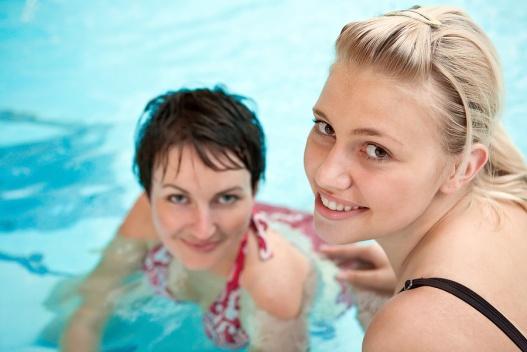Adults Learning to Swim
More than a third of adults in the United States can’t swim the length of a pool, according to the Centers for Disease Control and Prevention, which puts them at risk of being one of the 10 people who drown every day in this country.
In the Austin area, we have lots of creeks, lakes, rivers…and programs like triathlons and swim meets…that are available for adults to participate in year round. It is an important life skill to be able to swim comfortably…and an exercise you can turn into a fitness activity.
It’s important to find the right program for you. Make sure you visit the company, talk with the instructors and see others taking lessons to make sure you will be in a safe environment and with a knowledgeable instructor.
Here’s some techniques on how Waterloo Swimming teaches Adults how to swim:
Technique #1
Discover their swimming background, goals, fears, & reason they decided to take lessons now. Adults bring with them a lifetime of experiences and knowledge with them to the swim instruction setting. Whatever their swimming background, it’s rooted in experiences that lead up to this point in time. We visit with each adult to understand what their background is and assess their immediate comfort both around and in the water. We might have lessons for adults who are training for a triathlon competition or adults who have never been in a swimming pool, river, lake, etc. It is important to know their background to provide the upmost safety for the student and the instructor.
Technique #2
Design the swim lessons plans according to the goals, skills, & timeline of the adult. Once we understand the adult’s swimming background, we tailor their lesson plans according their goals. The instructor should outline the swim lesson plan to the adult with clear objectives and realistic timelines. It’s essential to “get on the same page” with the adult’s swimming goals to tailor the instruction for maximum success. This creates a roadmap that the instructor and adult can use to provide feedback on progress.
Technique #3
Talk to adults as adults and let them know “why.” Once in the water and instructing, we make sure we talk to the adult – as an adult. Like any other situation, adults want to be treated as such. This sounds straight forward, but I’ve seen instructors fall back to “kid instruction” which can frustrate and insult adults. Keep the conversation moving by asking them “how did that feel” after the student attempts a skill. As well, tell the adult “why” they are about to try a skill so that they understand. Adults will comprehend what’s working and what’s not working …so, explain it to them.
Technique #4
Use various learning methods when instructing adjusting to the adult’s learning style. It’s important to understand how each adult learns best – whether it’s visual, auditory, or kinesthetic. We start out using auditory cues to describe the skill the adult is to attempt, following up with a visual example when necessary. For example, we use the term “Starfish” when asking the students to float on their backs to describe the position we want our student’s body in. Sometimes, it takes showing what the “starfish position” looks like in order for the student to understand what we are looking for in the skill. Finally, use kinesthetic techniques or physical motions to supplement learning. For example, the instructor may need to get behind the student and hold on to his feet/ankles to assist proper freestyle kicking motion.
Technique #5
Don’t tell Students what they are doing wrong, tell them what to do to correct what they are doing wrong. Correct maximum impact issues first. Keep instructions simple and short. Don’t give long lists of instructions or paragraphs of words to think about when they swim. Focus on one, two or three issues at a time such as: “PUSH OFF HARD, STREAMLINE, KICK SMALL”. We watch the student swim, give them feedback, ask them to swim again.
Technique #6
Be patient and flexible when implementing lesson plans. Be flexible with the game plan on teaching. Look and listen, watch the adult’s motions and emotions, pay attention to their disposition. How are they following instructions? Determine how teachable the student is. Some learn quickly, others might take more time. The timeline may need slow down or speed up to make sure they learn the most important lessons. For example, we had one adult trying to learn the correct breaststroke kick position… she tried and tried, becoming frustrated. We took a break from practicing it by doing something completely different. She tried breaststroke again in the next lesson performing it correctly.
Technique #7
Homework…it’s not just for the kids. Some adults have access to alternative pools where they can practice skills learned with you. Map out drills and techniques for them to practice between their swim lessons. Make sure the drill is either practiced in the lesson or easily understood. Remind them never to swim alone or in unsafe water.
Technique #8
Positive experience. Teaching swimming to a person any age is a rewarding experience. Watching a toddler learn to float or a child swim across the pool for the first time is always exciting as they are learning the skills for survival and swimming for fun. While teaching adults is not necessarily in the fore-front of the learn-to-swim industry, it can be an amazingly rewarding experience for both the instructor and the adult. We use positive motivation to encourage our students’ progress and we see their swim skills advance.
As an instructor, these techniques will help ensure a good swim lesson experience is had by both the instructor and the adult. We utilize these techniques and our “tool belt” of drills and skills to continue building on the fundamentals of swimming. For adults looking for quality swim instruction, investigate the swim school/instructor’s philosophy on teaching adults to see what their techniques are in their swim program.
For more information, visit us at https://waterlooswimming.com/adult-swim-programs/

